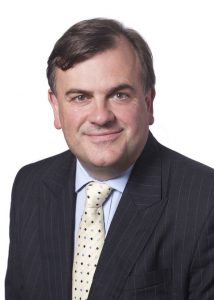
From left:Jide Adesokan, Gemina Cooper, Temi Binitie and Adedoyin Afun.
Multi-billion dollar risks of offshore energy projects emphasised at Afrimari event hosted by Stephenson Harwood
By James Brewer
Enormous risks associated with offshore oil and gas schemes were highlighted at the latest Afrimari shipping network event.
The meeting was hosted by London-headquartered law firm Stephenson Harwood, which has a substantial Africa Group practice, and a major presence in the energy and shipping sectors.

Stuart Beadnall
The choice of subject, under the title Afrimari goes Offshore, was prescient. The scale of the challenges was underscored just three days later when Royal Dutch Shell announced a halt to its $7bn drilling programme offshore Alaska, following disappointing results from Chukchi Sea exploration. The likely cost to Shell of abandoning contractual commitments will be $1.1bn.
Most West African offshore developments rely on the use of floating production, storage and offloading (FPSO) vessels to get the oil to market. Stuart Beadnall, a partner at Stephenson Harwood specialising in shipping and energy, said there were many floating production projects off the west coast – he had counted 18 off Angola and 13 off Nigeria, among others.
He stressed that FPSOs were each designed to be compatible with a particular reservoir.
“You have to get it right, ” said Mr Beadnall. “The cost over-runs can be huge – they can be double the original estimate.” A $1bn outlay might be needed “for a facility producing for five, six or seven years, and you might find that – oops! – production is going to finish in two years.”
In such cases, what was the prospect of subsequent employment? – Zero, at present.

Adedoyin Afun.
Repair and maintenance had to be done offshore, and production and offloading could resume only when the FPSO was fully functioning.
Mr Beadnall said that off Brazil there could be a water depth of 3, 000 m before one gets to the seabed, and a further 3, 000 m before one gets to the oil, and similar conditions pertained for Angola.
He said that operators had to respect rules about local content. In Nigeria there was a requirement for 51% local input, and some of that work could be done in local yards.
Mr Beadnall turned to recent interest in potential floating liquefied natural gas (FLNG) units, but noted that no-one had yet begun to install such a massive facility. The intellectual property involved in such new technology was immense … historically almost like someone producing the iPhone. Extraction could result in liquefied petroleum gas being released as well as liquefied natural gas: “imagine the complications of that.”
Before anyone invested in an FLNG, they would need to have a receiver who was willing to take a large amount of gas, said Mr Beadnall.
Mr Beadnall has been lead adviser on many FPSO projects in the North Sea, West Africa and Australia, negotiating contracts and resolving disputes, including Balder FPU, the largest ever FPSO litigation.
Jide Adesokan, an associate in the Stephenson Harwood marine and international trade department with offshore, marine insurance and shipbuilding experience, said that the offshore sector had continued to grow despite the fall in the oil price. Projects largely concentrated on finding gas because oil was more expensive and comparatively difficult to reach.
Mr Adesokan referred to the big disasters, including the Deepwater Horizon and Piper Alpha, and said that the main risks in the sector included loss of life, injury, pollution, damage to and loss of property, and suspended production. The overwhelming number of accidents in the sector was caused by the human factor, he said.

Beautiful bead motif of Stephenson Harwood’s Africa practice Group
He explained how contractual risk was allocated in offshore projects in contrast to most cases elsewhere where liability was on a ‘fault’ basis.
In the offshore sector for many years risks have been indemnified on a ‘no fault’ basis known as ‘knock-for-knock’ or ‘mutual hold harmless.’ Each party to a contract is responsible for and indemnifies the other for loss or damage regarding its own personnel and property, no matter who is to blame. This applies also to people and property of contractors and sub-contractors. Premiums are paid on the knock-for- knock basis, thus reducing the insurance cost and enabling higher levels of cover.
Some people might say that the knock-for-knock regime is ridiculous and quite broad – it applies regardless of negligence – but it improves certainty, said Mr Adesokan. In the vast majority of cases, it avoids legal disputes.
In this context, Mr Adesokan reviewed the case of the 40-year-old semi-submersible platform A Turtlewhich in 2006 went aground at the remote South Atlantic island of Tristan da Cunha. The platform had been set adrift by the tug Mighty Deliverer, which had been contracted to tow it from Brazil to Singapore for rebuilding.
Adedoyin Afun, of Nigerian law firm Banwo & Ighodalo, examined implications of the January 2012 incident attributed to a blowout on the KS Endeavor drilling rig that engulfed in flames the liftboat Mako, chartered by Hercules Offshore to Chevron Nigeria for storage.
Mr Afun was accompanied by his colleague Nonso Azih. Banwo & Ighodalo, based in Lagos and Abuja, has a variety of specialities including corporate finance and restructuring, project finance, shipping, aviation, international trade and energy.
Temi Binitie, a co-founder of Afrimari with Gemina Cooper, said that the network for marine and energy professionals with an interest in Africa was thriving in its fifth year and was proud to include Stephenson Harwood among its members.
Winding up the evening following a lively question and answer session, Ms Binitie said that the presentations and discussions had prompted heightened appreciation of the issues in the offshore sector and enabled a huge amount of information to be amassed.





